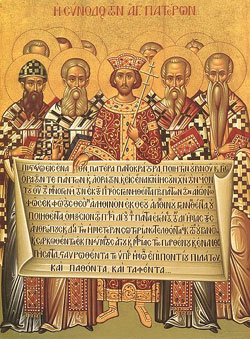Councils and Creeds
Councils

This has been the pattern of councils for most of church history.
- A question arises within the Church that is understood to be very important to the core understanding of what it means to be a Christian and differing opinions develop. This is not a question we can just agree to disagree about.
- The council meets to determine what the opinion of the Church should be
using
- Bible study,
- Prayer, and
- Reason
- a dogma or creedal statement is written.
The Roman Catholic Church recognizes twenty-one councils after the writing of the New Testament. Eastern Orthodox Churches recognize the first seven of these councils. The Oriental Orthodox churches recognize the first three of these councils. The Reformed Tradition (and Presbyterian churches within that tradition) values the work of councils and much of the theology developed in them. But we also believe that all councils may make mistakes. Creeds are not a replacement for Scripture or for the work of the Holy Spirit in your heart. But they are very important as statements of what thoughtful Christians believed, about a specific question, at that specific time. Below is a summary of the seven church councils which most branches of the Western and Eastern Orthodox Churches recognize.
Nicaea, 325 |
Question: Was Jesus God, human, or both? |
Constantinople, 381 |
Question: Was the Holy Spirit a person or a power of God? |
Ephesus, 431 |
Question: What is the nature of Jesus? |
Chalcedon, 451 |
Question: How can Jesus be both God and human? |
Constantinople, 553 |
Question: Was Jesus' nature divine or human? |
Constantinople, 680 |
Question: Which of Jesus' natures makes the decisions? |
Nicaea, 787 |
Question: What may be done with images of God, Jesus and saints? |
Creeds
The Church develops creeds for two reasons
- to answer important questions about faith and
- to state what we believe in the words and terms of the current world.
The Presbyterian Church (U.S.A.) recognizes the following creeds. You may notice that they fall into three categories.
- Those in the early church that helped define Christianity,
- Those in the Reformation period (early 1500s to mid 1600s) which defined what Protestants believe, and
- Those more recent statements that are helping us understand what the church means in the world today.
Teaches how Jesus Christ and the Holy Spirit relate to God | |
Teaches the doctrine of the trinity | |
Teaches how we are saved and why we have a church | |
Teaches what we believe about the Lord's Table | |
Teaches what we believe about baptism and the covenant | |
Teaches the sovereignty of God and the authority of Scripture | |
Teaches the lordship of Jesus Christ and the limits of external authority | |
Teaches the need for reconciliation and inclusion in the church | |
Teaches a summary of faith |